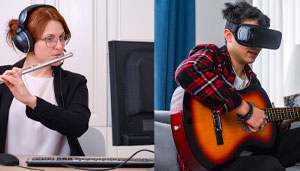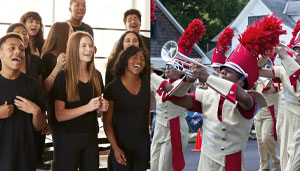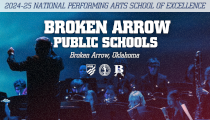Tips for Including Students with Visual Impairment in the Music Classroom
By Chase Crispin & Dr. Amy Spears on February 09, 2023 advocacy PrintThe music classroom is a place where students with visual impairment (VI) tend to feel included and equal to their sighted peers. It also provides an opportunity for socialization and for building social relationships when it may be more difficult in other academic areas. Despite this, many music educators tend to fear teaching a student with VI as there are few resources available to aid the teacher in accommodating these students. This article aims to provide some simple accommodations and resources that may be used to fully include a student with VI in the music classroom.
In order to learn more about how teachers teach students with VI, we traveled to a music festival hosted at the Perkins School for the Blind in May 2018. This festival involved over a hundred students from six different schools for the blind in the U.S. and Canada. We observed vocal and instrumental rehearsals and performances and interviewed the teachers to learn about the different techniques they use to teach their students. Though all students present had VI, many had additional disabilities, which required further accommodations.
We learned a great deal by visiting the music festival, but here I will cover the most relevant ideas for use in a mostly sighted classroom. They include aural learning, use of technology, verbal descriptions, use of braille or large print, and accommodations for instrumental students.
A common theme mentioned by teachers was to simply be clear- er when giving verbal instructions. Especially when using classroom visuals, teachers can use more specific wording. Instead of saying “the quarter note on this line,” say “the quarter note on the third line of the treble clef.” A student helper may be chosen to clarify images in films or games as necessary.
Perhaps the simplest form of accommodation for music students with VI is the use of audio recording technology. Teachers can digitally record the student’s part so they can listen as many times as necessary. They may also need to provide additional information on the recording as context to aid the student in memorization, such as time and key signature, roadmap of the piece, and a verbal description of dynamic, stylistic, and articulation markings.
Literary braille, which is quite different than musical braille, can be a useful aid in the classroom. Some of the teachers we interviewed wrote out the solfege or letter names which were converted to braille to help students learn their parts; it would also be helpful when the class focuses on sight reading exercises or simply in learning their parts. The lyrics to vocal music, along with major rehears- al markings or print page numbers, will aid the student in memorizing and keeping up with their peers. Teachers could also easily have a roadmap for an instrumental part brailled, or the letters A-G, to give reminders about pitches. Ultimately, the music teacher should discuss the student’s braille knowledge and needs with their teacher of students with visual impairment (TVI) so that they can have appropriate material produced by coordinating with a certified braille transcriber.
Though full braille music notation exists, it may not be the best option for all students. Reading braille notation requires students to learn a new meaning for each braille sym- bol they already know, and the code is complex and confusing at first for many students because of its reliance on intervals. The teachers we interviewed generally did not use braille music—only one teacher did for a specific student because that student requested to learn it. If a student wants to pursue learn- ing braille music, they must first be extremely fluent in reading literary braille. In that case, I (Chase) would personally recommend the student take distance learning courses such as those from the Hadley Institute for the Blind to aid in this process. If sighted music teachers want to learn more about the system, there is free material available online from Hadley, the National Braille Pres, and the Braille Authority that provides an overview of the braille music system.
Students with some functional vision can benefit from reading enlarged print or contrasting colors. Enlarging both text and notation may be helpful to students with low vision. Inverting the colors on the page may create the contrast that enables a student to begin reading music. Bright, contrasting colors will help some students identify note heads, verses, or other musical concepts. Stickers with these colors can be applied to instruments to aid students in finding the correct key, position, bar, etc.
Aural, oral, and kinesthetic modeling are useful strategies as well. Students may benefit from feeling the teacher’s hands and position of an instrument. There are many adaptive tools designed specifically for these purposes. For example, moving the bow straight and knowing where it is on the string is challenging for many beginners with VI. Teachers at the festival helped be- ginners by using bow guides, which enable the student to keep the bow moving in a constant direction until they retain muscle memory. Teach- ers also creatively used Velcro and other textured materials for other instrumentalists. Each teacher we interviewed at the festival ultimately had the same ad- vice: “Don’t be afraid.” Talking to the student, parent, special education coordinator, and the student’s other teachers can help the music teacher determine what accommodation the student receives in other classes and to generate ideas for strategies that will be helpful in music class. Contact the school for the blind in your state for additional resources and support is also a great option to consider. Students with VI are often extremely successful in music. With an open-minded teacher, some simple accommodations, and communication with others in the school, those students can thrive in music class, better connect with their peers, and develop their confidence as musicians.
Chase Crispin currently teaches vocal and general music classes at Scott Middle School in Lincoln, NE. In addition to directing the sixth-eighth grade choirs, he sponsors the Ukulele Club and directs the Clarinet Chamber Ensemble. he teaches general music electives and has created a Unified Music course, bringing students in Life Skills together with eighth-grade peers to make music together. His pedagogical passion is creating an inclusive curriculum that increases musical opportunities for all students. Chase received his Bachelor of Music Education from Nebraska Wesleyan University in 2019. He can be reached at [email protected].
Amy Spears is Associate Professor of Music at Nebraska Wesleyan University where she teaches courses in music education, world music drumming, and rock band. Her research interests include popular music pedagogy, internationalizing music curricula, and diversifying music education to include marginalized individuals. Dr. Spears can be reached at [email protected].
Chase Crispin & Dr. Amy Spears
This article first appeared in NMEA’s Nebraska Music Educators Magazine, March 2019 edition. The Nebraska Music Education Association is committed to building a robust statewide community of qualified music educators and allies by cultivating genuine relationships, advancing music education, and advocating for the profession. Check out the Nebraska Music Educators Association here: (https://www.nmeanebraska.org/)
Most Recent Articles







